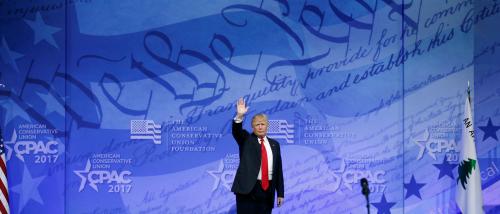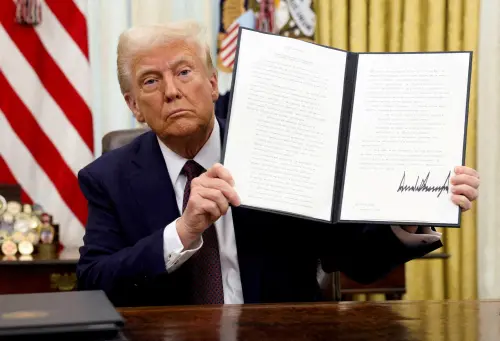As President Barack Obama prepares to leave the White House after eight years, what lessons should we take away from his experience working with Congress? The relationship was certainly marked by successes, like the adoption of major legislation including the Affordable Care Act and the Dodd-Frank financial reform law, and failures, such as the decision by Senate Republicans to refuse to consider the president’s nomination of Merrick Garland to the Supreme Court.
These single events—and others—will certainly loom large in historical accounts of President Obama’s relationship with Congress. Journalistic treatments during the administration, meanwhile, often relayed criticism from members of the president’s own party about his efforts (or lack thereof) in working with Congress. Political science research, however, suggests that when we seek to understand executive-legislative relations in the Obama era, we should think less about personal skills and relationships and look more towards structural factors. Recent work on President Lyndon B. Johnson—famous for his “will and skill” in relation to Congress—suggests that even he was helped notably by contextual conditions favorable to continued, high-level bipartisan negotiation.
During the Obama years, chief among these structural factors was the level of polarization in Congress. As political scientists have documented, the Obama administration was marked by polarization at record highs. Using DW-NOMINATE (political scientists’ workhorse measure of congressional ideology), the first congress of the Obama years (111th) was “the most polarized ever,” and the 112th, 113th, and 114th each followed suit.
What have these record levels of polarization meant for the relationship between Congress and the president? One major consequence has been that, in the Senate, polarization has made it harder for presidents to reap the benefits of shared party control. Consistent threats from the minority party to obstruct the majority party’s policy priorities have made “getting to 60” the norm for passing significant legislation.
During the Obama administration, one indicator of increasing polarization in the Senate was that the gap (as measured by NOMINATE) between the most moderate member of the majority party and the most moderate member of the minority party has been at least as large in each successive congress as it was in the previous one. As the members of the minority party who might be persuaded to join the majority party in supporting a presidential initiative become more distant ideologically, building a sixty-vote coalition becomes more difficult.
Political scientists have documented the effects of this polarization on legislative outcomes in Congress. Work by Jon R. Bond, Richard Fleisher, and Jeffrey Cohen, for example, looks at how often the president “wins” on votes in Congress, and finds that when polarization in the Senate is higher, presidents of the same party as the Senate majority win less. Elsewhere, my Brookings colleague Sarah Binder has demonstrated how the relationship between unified party control of Congress and the White House and levels of legislative gridlock (that is, the share of agenda items on which Congress is able to complete action) has gotten weaker over time as polarization has increased.
Will we see a similar dynamic in the 115th Congress? Perhaps. On one hand, a relatively narrow 52-seat Republican Senate majority suggests that they could face similar challenges, especially given that speculation about the imminent demise of the filibuster may well be premature. On the other hand, however, questions remain about the approach Senate Democrats will use in the 115th Congress, especially given the set of seats that the party must defend in the chamber in 2018.
Polarization may well have less direct effects on the task of coalition-building in Congress in favor of the president’s initiatives as well. Political scientists have long debated whether more popular presidents have more success with Congress, finding mixed results. If higher approval ratings do make it easier for the president to get his way in the legislative arena, though, the story is likely an electoral one. Members of Congress, likely concerned about their own re-election prospects, may be less likely to vote against the position of the president when he is popular. Conversely, if the president is unpopular, legislators predisposed to disagree with him will feel less pressure to change their mind.
During the Obama administration, however, public approval of the president was highly polarized by party. Obama’s average approval rating among members of his own party (81 percent) was on par with that of his predecessors since Reagan, but his average approval among members of the opposite party (14 percent) was substantially lower than any of his four predecessors. This approval gap, moreover, grew over the course of the Obama administration, averaging roughly 65 percentage points in 2009 and approximately 77 percentage points in 2016. Given that the president was so unpopular with Republican voters, any appeals to GOP legislators—or even Democratic legislators representing more conservative states/districts–on the basis of presidential popularity likely fell on deaf ears. Public opinion on the current presidential transition is similarly polarized, suggesting that the 115th Congress may well face a similar dynamic.
Once President-elect Donald Trump is sworn in on January 20, we will return to unified government across both chambers of Congress and the White House for the first time since 2011. This arrangement is widely expected to usher in major policy changes in several issue areas, especially health care and tax policy, thanks in part to Republicans’ ability to use the expedited budget reconciliation process to adopt some budget-related legislation without the threat of a filibuster in the Senate. In other areas, however, Republicans may find themselves re-learning an important lesson of the Obama years: unified party control may not be the blank check that a new president thinks it is.
The Brookings Institution is committed to quality, independence, and impact.
We are supported by a diverse array of funders. In line with our values and policies, each Brookings publication represents the sole views of its author(s).






Commentary
President Obama’s legislative legacy and what it means for the next administration
December 30, 2016